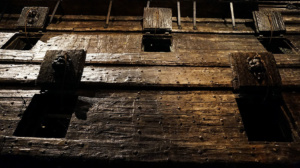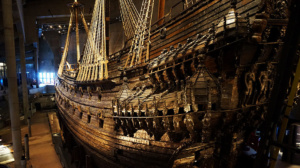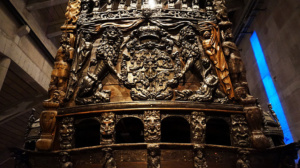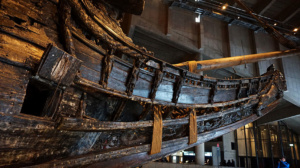This is a short but yet historic moment portraying the day when the Swedish royal warship Vasa was released from the harbour of Stockholm. Her maiden voyage would be filled with glory, war, and success, but reality took her through a dark journey lasting for over 300 years.

On the other side of the water, they can see the spectacle of this early morning’s attention. The king’s castle stands tall and powerful with big royal navy flags waving in the air. The “greatest ship ever built” is soon going to be released from her ropes, be waved goodbye to, and with great success dominate the war in Poland.
Vasa is her name, a powerful warship, exclusively built with the finest oak trees in the county. Details of solid gold are richly decorated on her back and at the front. A bright coat of royal colours on well-sculpted figures make her look far more unique than other ships before her. Vasa shall be seen through enemies eyes with fear and awe at the same time, that’s how beautiful she looks.
Suddenly, a long drumroll is echoing over the waters. The attention is now thick as the richest cream there ever was. Sigfrid sits up in haste as he was falling half asleep. He climbs up on an empty fish barrel to see what is happening. He must admit it is an impressive sight compared to his boat who is more like a floating thimble. 5 canons are fired as a salute for future success in the far distant land. Big axes cut off the ropes who held her with enormous strength. Trumpets, seagulls, and applause are competing against each other. The front of Vasa makes a beautiful cut through the water as if she is a sharp knife forcing herself through soft linen. Sailors onboard are waving as the ship slowly passes the cheering crowd. “People will drop their jaws,” Sigfrid whispers to himself admiring the ship as the sunbeams make the gold decorations shine so bright that it is hard for him to keep his eyes open.

If the story would end here it would have been nice. But Vasa and its crew will face a harsh reality and a different story. After a few minutes on the sea, the impossible happens. The royal regal ship Vasa is sinking, she is too heavy on the top. The canons are rolling over and forcing her down. It does not even take a minute until she is laying on her side being buried with water. The thick canvas sail that would have steered them to success is now steering many of the men to their death as its weight presses them down under water. People are jumping over the gunwale in panic, some of them climbing the masts. Many are saved but 30 people follow Vasa down to the bottom where the story ends in deep dark mud.
In silence, she is resting for over 300 years at the bottom before a man named Anders Franzén decides it is time to wake her up. The year is 1956 and if Vasa had eyes she would not believe how much the town changed since she last saw it.
It took almost 5 years to bring her up from the water, and for 27 years she has to stand in moist air since the normal air would destroy her. Vasa is 95% completely intact thanks to the sludge she had been buried in. That is an impressive “face mask” for a well-preserved lady like her.
Today she is resting at her own museum on the island next to where she once sank. She is one of the worlds most beautiful ships from the 17th century. In fact, there is no other ship from the 1600s that is so intact and well preserved as Vasa. Maybe her lifespan didn’t involve heroic war tales and exciting missions in lands far away, maybe her greatness was meant to be something else. As I study her fantastic details, brilliant craftsmanship, embracing the idea how much time it must have taken the artists to finish such marvelous work; I see rather a piece of art than a ship used for war. I can hear Sigfrid’s voice echoing in my head “people will drop their jaws”. And sure we do, not only the locals but people from all over the world. I see the same amazed expression when they stand face to face with the “greatest ship there ever was.”

Book tips: (...see links below) To the Left: Vasa: A Swedish Warship To the Right: The Vasa Saga: The Story of a Ship
If you ever have a chance to visit Stockholm, Sweden, don’t forget to visit her on the island called Djurgården, the green oasis in the middle of the city. (If it’s not winter time, as it was when we went.) I hope you will enjoy the rest of our video & photos exploring the snow-covered surroundings of the island. (GALLERY BELOW)
The Museum of Vasa Homepage: …Click Here!
Visit Stockholm: …Click Here!
Svensk Historia (In Swedish): …Click Here!
Thanks for reading!
-Jonas & Lindsay
[supsystic-gallery id=34]








Comments
Great written! It feels like as if I was there! Keep up the good work you two!
Author
Thank you so much for the nice comment, glad you enjoyed the read and trip to Vasa with us!